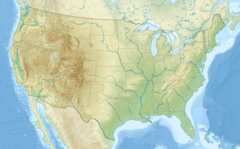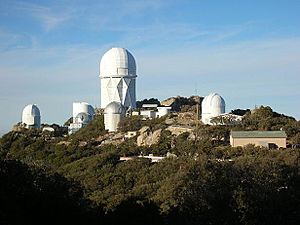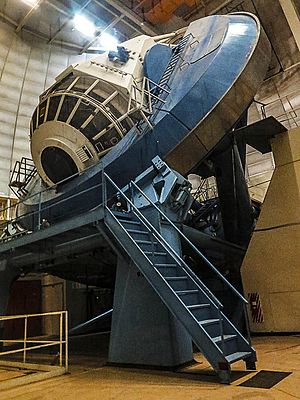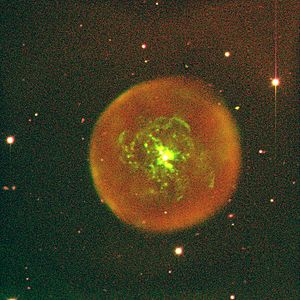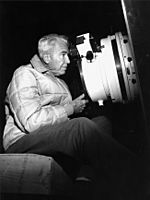Nicholas U. Mayall Telescope facts for kids
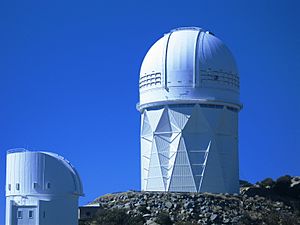 |
|
| Alternative names | Mayall 4-meter Telescope |
|---|---|
| Part of | Kitt Peak National Observatory |
| Location(s) | Arizona |
| Coordinates | 31°57′48″N 111°36′00″W / 31.9634°N 111.6°W |
| Organization | NOIRLab |
| Altitude | 2,120 m (6,960 ft) |
| First light | February 27, 1973 |
| Discovered | Methane ice on Pluto |
| Telescope style | optical telescope Ritchey–Chrétien telescope |
| Diameter | 4 m (13 ft 1 in) |
| Collecting area | 11.4 m2 (123 sq ft) |
| Website | noirlab |
The Nicholas U. Mayall Telescope, also called the Mayall 4-meter Telescope, is a very large telescope. It is located at the Kitt Peak National Observatory in Arizona, USA. This telescope is named after Nicholas U. Mayall, an important astronomer. It first started working on February 27, 1973. At that time, it was the second-largest telescope in the world!
The main mirror of the telescope is 4 meters (about 13 feet) wide. It is made from a special type of glass called fused quartz. This material is good because it does not change size much with temperature. The telescope helps scientists study distant objects in space.
Contents
Building the Mayall Telescope
In 1961, Nicholas Mayall suggested building a very large telescope at Kitt Peak. This was after other telescopes were already being built there. Construction work for the telescope started in 1968. By 1971, the huge mirror was brought to the site.
Making the Giant Mirror
The telescope's main mirror was made by a company called Owens-Illinois. It was made from a thick disk of fused quartz. This material is special because it does not expand or shrink much when the temperature changes. This is very important for a telescope mirror to stay accurate. The mirror was then carefully shaped at the Kitt Peak optical lab.
First Look at the Stars
The Mayall Telescope first saw light from space on February 27, 1973. Some of the first people to use it were David Crawford, Nicholas Mayall, and Arthur Hoag. The telescope was officially named after Nicholas Mayall on June 20, 1973. This happened after he retired as the director of the observatory.
Tools for Space Exploration
Over the years, many different tools have been used with the Mayall Telescope. These tools help astronomers collect different kinds of information from space. Some examples include special cameras and devices that break light into its colors, called spectrographs.
The Fourier Transform Spectrograph
One important tool used with the Mayall Telescope was the Fourier Transform Spectrograph (FTS). It was used from 1975 to 1995. This tool helped scientists collect detailed information about the light from stars and other objects. It was especially good at studying infrared light before newer technologies existed. Over its time, the FTS collected about 10,000 light patterns from 800 different space objects.
Dark Energy Spectroscopic Instrument (DESI)
A very important new tool called the Dark Energy Spectroscopic Instrument (DESI) was finished in late 2019. DESI is designed to help scientists learn more about dark energy. Dark energy is a mysterious force that seems to be making our universe expand faster and faster.
DESI has 5,000 tiny fiber optic sensors. Each sensor can be aimed by a robot at a different galaxy or quasar. Scientists plan to study millions of these objects to understand dark energy better. This instrument took ten years to build and involved many researchers. DESI started working in 2019, but full operations were delayed until mid-2021 due to the COVID-19 pandemic.
Amazing Discoveries

The Mayall Telescope has helped make some exciting discoveries about our universe.
- In 1976, scientists used the Mayall Telescope to find methane ice on the dwarf planet Pluto.
- The FTS tool on the Mayall was also used to study methane in the outer parts of our solar system. In the 1980s, it helped study methane on Titan, a moon of Saturn known for its thick atmosphere.
- The Mayall Telescope also helped study the Andromeda Galaxy. These observations helped scientists understand the history of that galaxy. This, in turn, helps us understand our own galaxy, the Milky Way.
Mayall's Place Among Telescopes
When the Mayall Telescope was first opened in 1973, it was the second-largest telescope in the world. Only the Hale Telescope, which is even bigger, was larger.
Here is how the Mayall Telescope compared to other large telescopes in 1973:
| # | Name / Observatory |
Image | Aperture | First Light |
|---|---|---|---|---|
| 1 | Hale Telescope Palomar Obs. |
200 inch 508 cm |
1949 | |
| 2 | Mayall Telescope Kitt Peak National Obs. |
158 inch 401 cm |
1973 | |
| 3 | Shane Telescope Lick Observatory |
120 inch 305 cm |
1959 | |
| 4 | Harlan J. Smith Telescope McDonald Observatory |
107 in 270 cm |
1968 |
Here is a picture of Nicholas U. Mayall himself looking through the telescope that would be named after him:
Images for kids
See also
 In Spanish: Telescopio Mayall para niños
In Spanish: Telescopio Mayall para niños
- List of astronomical observatories
- List of largest optical reflecting telescopes
- List of largest optical telescopes in the 20th century
- List of the largest optical telescopes in North America
- Lists of telescopes


